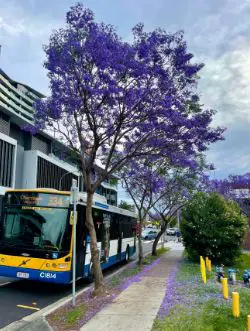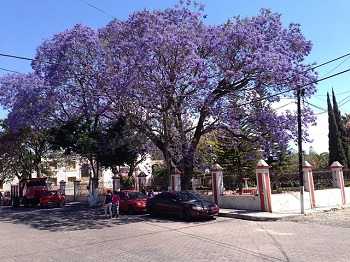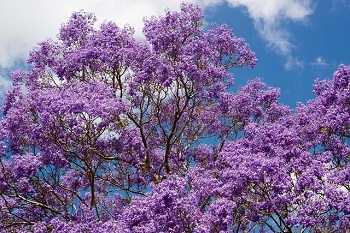During the spring, jacaranda trees are famed for their exquisite purple blooms that cover their branches. Although these trees are native to South America, their visual appeal has helped them gain popularity across the globe. Jacaranda trees, like anything else, have advantages and disadvantages. In this blog post, we will explore the Jacaranda tree pros and cons in your yard.
| Pros | Cons |
|---|---|
| Attractive appearance | Susceptible to disease |
| Tolerates partial shade | Requires space to grow |
| Thrives in urban environments | Not frost-tolerant |
| Long blooming season | Can be messy |
| Provides shade | Not suitable for coastal regions |
Pro: Attractive Appearance
The jacaranda tree’s distinctive and lovely beauty makes it a pleasure to see. This deciduous or evergreen tree has branches that create a canopy like an upturned umbrella and may reach heights of 5 to 15 meters. With its up to 20-inch-long, fern-like leaves, the jacaranda tree makes a fantastic shade tree. The tree is a lovely addition to any environment because of its gorgeous leaves, which also give it a special texture.
The magnificent lavender-blue blossoms on the jacaranda tree are one of its most distinctive characteristics. Intense clusters of these trumpet-shaped blooms cover the tree throughout the spring and summer, turning it into a focal point in any yard or street. The cherry blossoms of the city of Los Angeles are a tree whose beautiful petals have made it one of the city’s most iconic plants.
The jacaranda tree’s leaves are a distinctive and lovely aspect. They may reach a length of 20 inches, are green, and resemble ferns. The tree is a popular option for landscaping because of the feathery texture of its leaves, which enhances the tree’s attractiveness.
Jacaranda trees are not only lovely, but they also exude an air of luxury and exoticism. They are a great option for anybody searching for a tree that will give their landscape a dash of class and refinement. The tree’s attractiveness is not only in the way it looks; it also has a delicious aroma that adds to its allure.
The jacaranda tree thrives in dry climates and is a great option for places with little rainfall. It is a low-maintenance tree since it is resistant to a variety of insects and illnesses. In addition, the tree grows quickly in tropical climates, acquiring roughly ten feet each year during the first several years of its existence.

Pro: Tolerates Partial Shade
A tropical tree species known as the jacaranda thrives in full sun and sandy, well-drained soils. Even under less-than-ideal circumstances, they can withstand partial shadow and still grow swiftly.
Smaller jacaranda trees may withstand little shade if required, but full sun is best for producing the most flowers, according to the University of Florida. The quantity and brilliance of their flowers might be affected by inadequate sunshine. Although a jacaranda may thrive in some shade, The Green Pinky contends that it will flourish and produce more flowers in direct sunlight.
Jacaranda trees tolerate most soil types, although they thrive in well-draining, somewhat sandy soil. All year round, these trees need to be watered, and during dry spells, regular irrigation may be necessary. In terms of maintenance, the SFGate suggests treating with a 10-10-10 fertilizer at the start of spring to encourage healthy development.
Although jacaranda trees grow rather quickly, it takes saplings many years to mature and start flowering. They are generally low-maintenance trees that may give a lovely splash of color to any landscape once they are established. They do, however, have significant drawbacks. Jacaranda trees are prone to branch breakage due to their thin wood, according to research from the University of Florida, especially in storms or strong winds. Planting them next to pathways or roads may not be the best option since the blooms and leaves that fall may be extremely untidy.

Pro: Thrives in Urban Environments
The jacaranda tree is adored by gardeners and urban designers alike for its breathtaking display of lavender or purple flowers that bloom in the spring and early summer. The jacaranda tree has gained popularity in recent years as a preferred option for urban settings due to its ability to survive there.
The Environmental Horticulture department at the University of Florida did research on the jacaranda tree’s development patterns and discovered that sandy, well-drained soils are the optimum for the tree’s growth. Even while it thrives in full sun, it can endure a little moderate shade and still grow swiftly. Jacaranda trees thrive in warm, subtropical climates and can endure extreme heat and severe drought. Because of its ability to resist the challenging circumstances of city life, it makes a suitable tree for many metropolitan locations.
The Jacaranda tree has the benefit of being resistant to pests and diseases, making it a low-maintenance tree that, once established, needs little upkeep. It also has strong roots that enable it to survive in urban areas with often poor soil quality. The tree is well suited for planting beside sidewalks and in other urban environments due to its shallow root structure.
The Jacaranda tree has certain disadvantages despite its numerous benefits. If not kept up with, its shallow roots may sometimes harm sidewalks and other hardscapes. Additionally, planting in constrained urban areas may be challenging because of its big size.

Pro: Long Blooming Season
Jacaranda thrives in warm regions and is well-adapted to USDA Hardiness Zones 9B through 11. The jacaranda blooms throughout the spring and summer, often in May, but sometimes in April or even in August. It has trumpet-shaped, mauve to deep purple blooms that, during flowering season, give the tree a very distinctive appearance.
Jacaranda trees come in 49 different species, but the Jacaranda mimosifolia, sometimes referred to as the “blue jacaranda,” is the most common in several areas, notably Los Angeles, California. Two times a year, in the spring and autumn, this kind of tree may blossom; the spring flowering season lasts from late May to early June.
The blooms are plentiful in the late spring, from late April to early June, and their color contrasts brilliantly with the broad, complex leaves of the tree. Jacaranda trees like sandy soils with a pH range of neutral to acidic and need a well-drained environment to grow. Less mature trees could not blossom for the first few years, but older trees will produce many flowers in the spring or early summer.
Despite being non-native, Florida does not see the tree as a problematic species. The potential size of the tree must be taken into account when choosing a spot for planting since jacaranda trees may reach heights of 50 feet and widths of 30 feet.
Pro: Provides Shade
In the summer, jacaranda trees are a common option for shade. They are perfect for patios and outdoor lounging spaces because of their beautiful, broad canopies and fern-like foliage that provide diffused shade. Their adaptability in landscaping is increased by the fact that they may be cultivated in single- or multi-trunk varieties. Fast-growing evergreen jacaranda trees may reach heights of 50 to 60 feet. The jacaranda leaves fill in with fine-leaved foliage after the flowers have finished flowering, resulting in a dappled shadow environment under the canopy.
If required, jacaranda trees can withstand some mild shade, but it’s important to remember that this may affect how many and how vibrantly their blossoms are. As a result, it is ideal to plant them where there is enough of sunshine, and healthy soils with good drainage are also required. Jacaranda trees don’t need much trimming and are low-maintenance. They create excellent shade trees due to their highly textured leaves and wide, spreading branches.
Jacaranda trees are a great option for landscaping in places like Los Angeles since they are drought-tolerant, quick-growing, wildlife-friendly, and sidewalk-protecting. The purple-blue blossoms on these trees, which are a recognizable feature of the landscape in Australia and Southern California, herald the arrival of spring and summer. Depending on the size and age of the tree, they are sold in a variety of sizes, from seeds to mature trees, and their prices vary from reasonably priced to fairly costly. In conclusion, the jacaranda tree is a lovely, quickly-growing, and adaptable tree that enhances the attractiveness of the environment overall and offers much-needed shade in hotter seasons.

Con: Susceptible to Disease
The dangerous bacterial illness known as oleander leaf scorch disease may also affect jacaranda trees. There is no remedy for this deadly illness, thus the tree inevitably perishes.
Jacaranda trees, like other garden plants, may draw aphids and scale in addition to bacterial illness. These insects destroy the tree’s leaves and stems by feeding on them, which lowers the tree’s general health.
In addition to these problems, jacaranda trees are susceptible to mushroom root rot, which is brought about by over watering and inadequate drainage. The tree’s active root system may also be a source of issues since it may grow invasive and impact surrounding drains, pipelines, water lines, and pathways.
Spraying aphid-infested foliage with insecticidal soap, neem oil, or a constant stream of water is advised to avoid these issues. Root rot may be avoided by providing the right amount of drainage and irrigation. Additionally, it’s essential to place jacaranda trees where their roots won’t interfere with neighboring buildings.
Con: Requires Space to Grow
To develop correctly, the jacaranda tree needs a lot of area. A mature jacaranda tree may grow to be 25–50 feet tall and 15–30 feet wide. Because of this, it can only be used in expansive backyards, parks, or streets. Jacaranda trees may develop insufficiently and unhealthily if they are planted in small areas.
It’s essential to take their space needs into account while planting jacaranda trees. A jacaranda tree won’t grow to its full potential if it is planted in a limited area, such a tiny backyard or next to a structure. Because the tree’s roots may spread far and deep, it may potentially harm nearby buildings.
A lot of sunshine is necessary for jacaranda trees to thrive and produce strong, colorful blossoms year after year. They need six to eight hours a day of direct sunshine. Additionally, you should choose a spot that is shielded from high winds since such conditions might harm the tree’s fragile limbs.
Cuttings or seedlings may be used to grow jacaranda trees. Choose a spot with lots of room for the roots to spread out if you’re planting a Jacaranda tree from a seedling. Create a hole that is exactly as deep and twice as broad as the root ball of the tree. After inserting the tree, partly fill the hole with earth. After thoroughly watering the tree, fill the hole with dirt and push it down to remove any air pockets.
Con: Not Frost-Tolerant
Some varieties of jacaranda trees may live in temperatures as low as 20 degrees Fahrenheit (-6.6 degrees Celsius), but they cannot endure in locations where it often drops below freezing.
Depending on the age and maturity of the tree, jacaranda trees may endure freezing temperatures. Only temperatures below 30 degrees Fahrenheit may be tolerated by young trees due to their lesser tolerance for cold weather. A mature Jacaranda tree, however, can withstand cold periods of up to 25 degrees Fahrenheit. The tree may get damaged or possibly die if it is exposed to frigid conditions.
There are certain measures you may take to safeguard the Jacaranda tree if you want to plant one but live in a region with harsh winters. Cover vulnerable plants and trees with burlap, sheets, tarps, or other things that reach the ground before freezing weather arrives to keep the earth’s collected warmth within. To reduce contact between the cover and the leaves, use a frame or pegs. Bring potted Jacaranda trees to more secure settings if you have any.
Con: Can Be Messy
It’s common for jacaranda trees to lose their blossoms, which may make a big mess. The blossoms are a hassle for gardeners and property owners to clean up since they often fall from the tree and land in gardens or on sidewalks. The tree’s tiny, frond-like leaves and seeds, in addition to the blooms, may make a mess when they fall off.
Despite being untidy, jacaranda trees are nonetheless a preferred option for landscaping because of their breathtaking beauty. They develop into big, beautiful street trees with strong roots that don’t damage the pavements. However, it is crucial to put them in the proper spot, away from sidewalks and other potential difficult-to-clean locations.
The messiness of jacaranda trees may turn some people off, but others think it’s a minor price to pay for their beauty. The tree’s messiness is something that many gardeners and homeowners are ready to put up with in order to appreciate its vivid purple blossoms. It’s crucial to remember that jacaranda trees need regular care to be strong and attractive. To ensure that the tree stays healthy and attractive for many years to come, proper trimming and watering are essential.
Con: Not Suitable for Coastal Regions
Because they are sensitive to salt spray and strong winds, jacaranda trees are not appropriate for coastal areas. Jacaranda foliage does not fare well when exposed to sea spray, thus it is recommended to avoid planting these trees near coastlines, according to a gardening guide from SFGATE.
Brazil is home to the jacaranda tree, which prefers a warm, subtropical environment. While they can survive dryness, during prolonged dry spells they need irrigation. Jacaranda trees grow best in well-draining, somewhat sandy, acidic soil. It can thrive in both loamy and clay soils, however it shouldn’t be planted in any heavy, wet, or poorly draining soil. Root rot is more likely to occur in soil that has been saturated.
If properly cared for, jacaranda trees may survive for 50 years or more. They can thrive in a variety of soil types with consistent moisture but excellent drainage and are resistant to pests and illnesses. The gentle, dappled shade that jacaranda trees are renowned for producing makes them ideal for cooling patios. Due of the frequent leaf and blossom drop, they probably shouldn’t be utilized next to pools.
There are several possibilities available if you’re seeking for a substitute for jacaranda trees in coastal areas. For instance, common selections that may flourish in coastal settings are palm, olive, and agave trees. It’s crucial to conduct your study and choose a tree that will thrive under the particular circumstances of your area.
I hope you find this article “Jacaranda tree pros and cons” helpful. As you know, these trees give shade, beauty, and maybe therapeutic advantages to any yard. Their spreading roots and dropping leaves and blossoms are drawbacks. Before planting a Jacaranda tree in your yard, examine the advantages and drawbacks to see whether it’s good for you. A Jacaranda tree can beautify any outdoor area with appropriate care.
Related Posts:
Zelkova Tree Pros and Cons: 7 Facts You Need to Know
Carrotwood Tree Pros and Cons: 10 Facts You Need to Know
Avocado Tree Pros and Cons: 10 Facts You Need to Know
